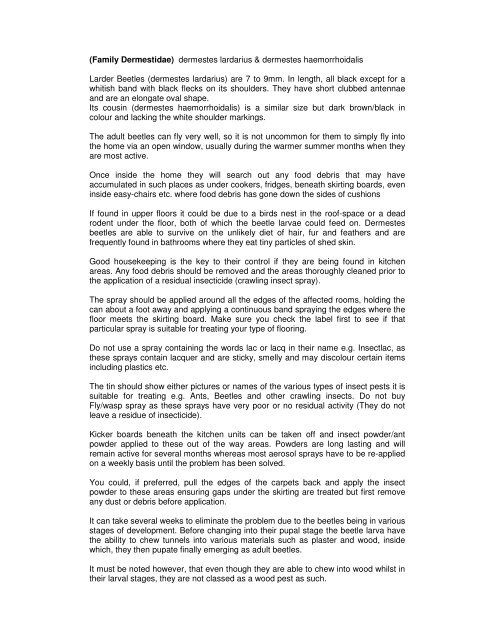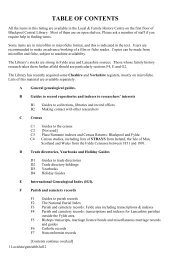You also want an ePaper? Increase the reach of your titles
YUMPU automatically turns print PDFs into web optimized ePapers that Google loves.
(Family Dermestidae) dermestes lardarius & dermestes haemorrhoidalis<br />
Larder <strong>Beetles</strong> (dermestes lardarius) are 7 to 9mm. In length, all black except for a<br />
whitish band with black flecks on its shoulders. They have short clubbed antennae<br />
and are an elongate oval shape.<br />
Its cousin (dermestes haemorrhoidalis) is a similar size but dark brown/black in<br />
colour and lacking the white shoulder markings.<br />
The adult beetles can fly very well, so it is not uncommon for them to simply fly into<br />
the home via an open window, usually during the warmer summer months when they<br />
are most active.<br />
Once inside the home they will search out any food debris that may have<br />
accumulated in such places as under cookers, fridges, beneath skirting boards, even<br />
inside easy-chairs etc. where food debris has gone down the sides of cushions<br />
If found in upper floors it could be due to a birds nest in the roof-space or a dead<br />
rodent under the floor, both of which the beetle larvae could feed on. Dermestes<br />
beetles are able to survive on the unlikely diet of hair, fur and feathers and are<br />
frequently found in bathrooms where they eat tiny particles of shed skin.<br />
Good housekeeping is the key to their control if they are being found in kitchen<br />
areas. Any food debris should be removed and the areas thoroughly cleaned prior to<br />
the application of a residual insecticide (crawling insect spray).<br />
The spray should be applied around all the edges of the affected rooms, holding the<br />
can about a foot away and applying a continuous band spraying the edges where the<br />
floor meets the skirting board. Make sure you check the label first to see if that<br />
particular spray is suitable for treating your type of flooring.<br />
Do not use a spray containing the words lac or lacq in their name e.g. Insectlac, as<br />
these sprays contain lacquer and are sticky, smelly and may discolour certain items<br />
including plastics etc.<br />
The tin should show either pictures or names of the various types of insect pests it is<br />
suitable for treating e.g. Ants, <strong>Beetles</strong> and other crawling insects. Do not buy<br />
Fly/wasp spray as these sprays have very poor or no residual activity (They do not<br />
leave a residue of insecticide).<br />
Kicker boards beneath the kitchen units can be taken off and insect powder/ant<br />
powder applied to these out of the way areas. Powders are long lasting and will<br />
remain active for several months whereas most aerosol sprays have to be re-applied<br />
on a weekly basis until the problem has been solved.<br />
You could, if preferred, pull the edges of the carpets back and apply the insect<br />
powder to these areas ensuring gaps under the skirting are treated but first remove<br />
any dust or debris before application.<br />
It can take several weeks to eliminate the problem due to the beetles being in various<br />
stages of development. Before changing into their pupal stage the beetle larva have<br />
the ability to chew tunnels into various materials such as plaster and wood, inside<br />
which, they then pupate finally emerging as adult beetles.<br />
It must be noted however, that even though they are able to chew into wood whilst in<br />
their larval stages, they are not classed as a wood pest as such.
During the colder winter months beetle activity can slow down or disappear<br />
altogether only to re- emerge once the temperatures increase in spring and summer.





![Control of contractors arrangements [PDF 45KB] - Blackpool ...](https://img.yumpu.com/21999918/1/184x260/control-of-contractors-arrangements-pdf-45kb-blackpool-.jpg?quality=85)
![Day service [PDF 137KB] - Blackpool Borough Council](https://img.yumpu.com/21999915/1/184x260/day-service-pdf-137kb-blackpool-borough-council.jpg?quality=85)
![Mental capacity policy [PDF 126KB] - Blackpool Borough Council](https://img.yumpu.com/21999914/1/184x260/mental-capacity-policy-pdf-126kb-blackpool-borough-council.jpg?quality=85)








